When’s the last time you walked outside barefoot? It’s fun to be in your bare feet and feel the texture of the ground and the way your feet move differently without shoes. But while it’s possible to run and hike barefoot, and some people embrace that wholeheartedly, many of us prefer to strike a balance between barefoot and big clunky “traditional” running shoes. Merrell’s M-Connect line of minimalist shoes is designed to give you everything-the feel of being barefoot, but the protection of shoes. They have a variety of models, from very minimal to hiking-oriented. Merrell was kind enough to send us samples of three shoes from the M-Connect line so we could see what made them special!
First, a word on minimal and lightweight shoes. If you haven’t already done so, check out our running shoe guide. It will help with an overview of minimal and traditional running shoes, as well as give a better idea of the vocabulary of athletic footwear.
Second, this is a long and detailed discussion, so for those who don’t have much time or want the Cliff’s Notes version: The M-Connect line combines light weight, quality construction and sole flexibility, and a low to zero heel to toe drop to make minimal shoes that fit a tremendous number of road and trail running areas. The shoes let your feet function naturally, which makes for a more stable, strong, and fun adventure, wherever you choose to take them. Be sure to read below the gallery for more information on M-Connect and why we’re so smitten here at Gear Diary with Merrell’s awesome shoes!

- Side view, Bare Access 2
- Toe caps, Bare Access 2 and Road Glove 2
- Heel raised approx. 10mm using CD cases. Note how it changes the arch and heel.
- Heel raised approx. 5mm using a CD case.
- Foot flat on the ground, same heel to toe position as a zero-drop shoe.
- Road Glove 2 sole
- Bare Access 2 sole
- Toe cap of Proterra Sport. Note the extra rubber to protect the toes on the trail.
- Side view, Proterra Sport
- Sole and lugs, Proterra Sport.
- Heel view, Proterra Sport
- Heel cups of the Road Glove 2 and Bare Access 2.
- Road Glove 2 rolled up inside itself. Handy if you only have room to store one shoe.
- L to R: Road Glove 2, Proterra Sport, Bare Access 2
- Icy dirt road, walking the dog wearing the Proterra Sport.
- Proterra Sport vs an icy snowbank (Proterra won)
- Rooster on icy dirt road in Maine who thought it was weird I was taking pictures of my shoes while standing on a snowbank.
All the M-Connect shoes share a certain “design DNA” that roots them in the light running shoe category. I looked at three styles, the Road Glove 2, the Bare Access 2, and the Proterra Sport. Road Glove was the most minimal, Bare Access was a touch thicker underfoot for those who like or need a bit of protection from the road, and Proterra is a lightweight hiking sneaker. All of them shared certain characteristics that, when combined, make for extremely impressive minimal footwear!
Weight:
I know, it’s not something that comes up in polite company. But weight is a big deal in a shoe. Lighter shoes may lead to less fatigue while on your feet, and if the shoe is incrementally less heavy, it’s that much easier to keep lifting and landing with good form. Of the shoes I tested, the Proterra is the heaviest, coming in at 13oz, while the Road Glove 2 and Bare Access 2 are downright svelte at 7.1oz and 6.2oz, respectively. If you’re not an obsessive shoe researcher, here’s how that breaks down compared to their competition (note that the Brooks Pure Connect is a more minimal shoe, while the Ravena, Elixer, Cascadia, and Kayano are all traditional shoes that are fairly popular):
-Brooks Pure Connect 2: 7.1oz
-Brooks Ravenna: 11oz
-Mizuno Wave Elixir: 9.2oz
-Asics Gel Kayano: 10.9oz
-Brooks Cascadia: 12oz
While 3-4oz may not seem like much on, that’s still a significant deviation, considering it has to come from somewhere. After all, all shoes have a sole, fabric, and laces…and that’s where the construction of the shoe comes in for our second major minimal characteristic.
Construction and Materials:
A typical running shoe has a fairly stiff upper and a thick rubber/foam/air pocket/gel/plastic inserted sole. A solid minimal shoe, like the Merrell M-Connect line, has a thin sole with rubber for traction along the bottom, and in the case of the road shoes not much for the upper. Both the Bare Access 2 and Road Glove 2 are made without a hard plastic heel cup, and are really just fabric and shoelace to hold the shoe on your foot. The Proterra has a bit more material and construction, but the Proterra is a hiking sneaker-you want a tougher shoe on your foot while you’re on the trails, but even with a more firm heel cup and toe protection the Proterra is still a simple shoe without much excess material or weight.
As a result of their more stripped down style, there’s no arch support. Your feet will definitely grow stronger in these! In addition, the midfoot (where the lacing comes across the top of your foot) is a bit on the snug side; it’s the main place where the shoes lock down on your foot, as the forefoot is designed to be roomier and give your feet and toes a chance to spread and bend as needed. The idea here is that your toes and forefoot are able to function naturally, providing stability and power to your every stride.
One other benefit of a more minimal shoe that should carry over into the M-Connect line: minimal shoes often last far longer than traditional ones. There’s no gel or foam or anything that can wear out. A well-constructed minimal shoe will last until you wear down the soles, and from the samples I have seen of the M-Connect options, there’s no doubt in my mind that a pair of these will last you a very long time. The likely weak spot in a minimal shoe is the uppers, since they are made of fabric, but Merrell seems to have that covered. The toe area is reinforced, so even if you drive your toes right to the edge you won’t put your big toe through the upper that easily. And there’s a similar band of reinforced fabric around the heel, which helps protect it in lieu of a heel cup on the non-trail shoes. Merrell has a well-deserved reputation for solid, dependable gear, and the quality of the construction of the M-Connect line is no exception.
Heel to Toe Drop:
Chances are, if you’ve heard of minimal shoes before or been unlucky enough to walk into an argument about them, one of the main issues no doubt centered around the heel to toe drop. This is a term that refers to how high the heel sits versus the forefoot, and it governs a great deal more than whether you get to be a few millimeters taller. Why does it matter? The argument goes something like this: If you were to tear off your shoes and head down the road in your bare feet, there’s a good chance that you’d land on your forefoot first, and not your heel. Why does that matter? For one, it’s more difficult to overextend your legs, putting excess pressure on your knees and hips, while landing on your forefoot. It’s not impossible, but for most people it’s not likely to happen regularly. As a result, you take quicker, shorter strides while barefoot, which studies have tentatively proven leads to less pounding on your body. From there, it follows that a minimal shoe, one that is flat or almost flat from the heel to the toe, lets your feet land in much the same way, giving you the softer landing and better form of running barefoot but the protection of shoes. A traditional shoe, on the other hand, does the opposite; because the heel is significantly higher, it is easier to land on your heels first, meaning it’s easy to slip into bad habits like slamming your heels into the ground and/or overstriding considerably.
I want to emphasize here that I am not a physical therapist or an exercise physiologist or an evolutionary biologist…but in my personal experience that theory plays out. I experience knee pain in a regular, traditional running shoe that I do not experience in minimal shoes, and I attribute that in large part to the fact that minimal shoes allow me to land on my forefoot comfortably. The M-Connect line is mainly made up of shoes that have a zero heel-to-toe drop, meaning your heel and forefoot are at the same height. Some of the trail options, like the Proterra, and their hybrid road/trail shoe the Mix Master, have a 4mm heel to toe drop. Some argue this means a shoe is no longer minimal, since the heel is slightly raised. To be honest, I didn’t actually notice the Proterra had a 4mm drop until I read the marketing materials-it feels like a zero-drop shoe. And it’s important to remember that 4mm is not a huge difference-it’s just shy of the height of the average CD case.
Once you get into “traditional” shoes, though, then you can see the dramatic difference. Let’s return to that list we had above of competing traditional shoes, only this time we’re looking at their heel to toe drops:
-Brooks Pure Connect: 5mm
-Brooks Ravenna: 10mm
-Mizuno Elixir: 13mm
-Asics Kayano: 10mm
-Brooks Cascadia: 10mm
(Heel to toe numbers and shoe weights courtesy of Running Warehouse)
To give you an idea, a 10mm heel to toe is almost two CD cases stacked on top of one another. Stand barefoot, then stick two CD cases under your heels. -Feel a difference in your posture and how your feet are situated? That’s what happens when you wear a traditional running shoe. And that’s why a 0-4mm heel to toe on the M-Connect line is so important!
The Whole Package:
Whether you’re primarily a road runner, a trail runner, or someone who covers a bit of everything, you need solid footwear. From the super-minimal Road Glove to the tough but easy on your feet Proterra, M-Connect has you covered! You can view the full line of M-Connect footwear here, or try them on in person at your local REI!








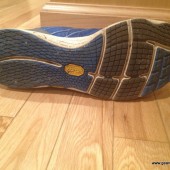

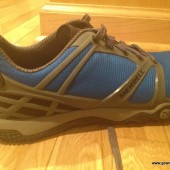

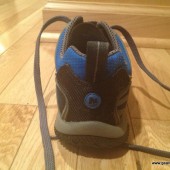






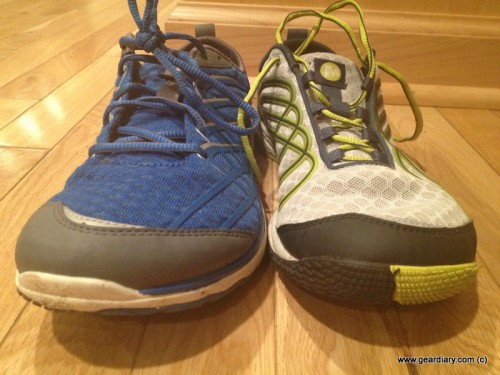

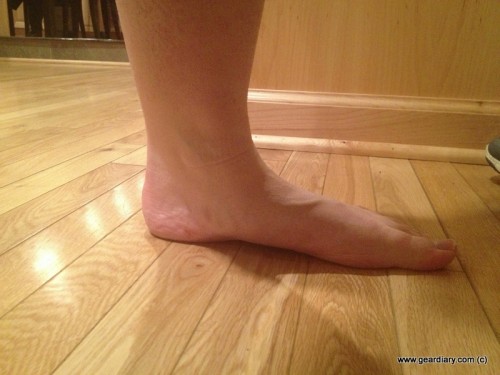


I recently read a good article in the NY Times that challenges the notion that forefoot striking is natural. The study confirms that forefoot and midfoot strike reduce impact, but may also transfer more impact to the lumbar spine. It’s still not defined science, and the Harvard study now seems less definitive.
However, if it works for you, that’s all that matters!
Times article: http://well.blogs.nytimes.com/2013/01/23/is-there-one-right-way-to-run
Original study: http://www.plosone.org/article/info%3Adoi%2F10.1371%2Fjournal.pone.0052548
Interesting stuff … and a reminder that so much of this is unknown and new. I am very happy with my 4mm drop shoes with light padding, so I am staying there so long as I stay happy and healthy 🙂 Like you say – find what works best for you!